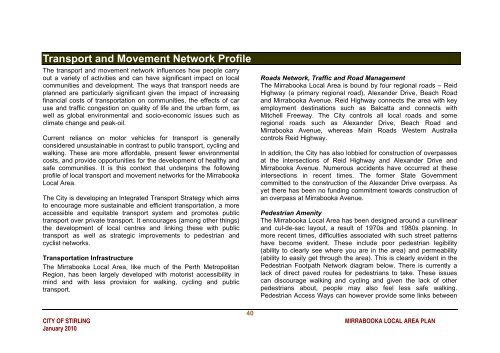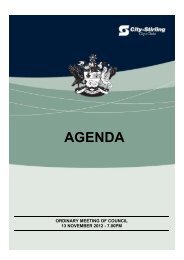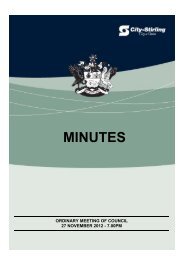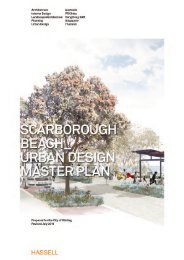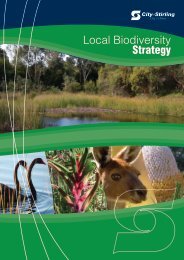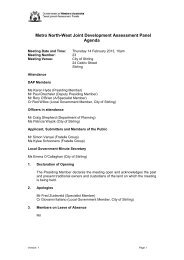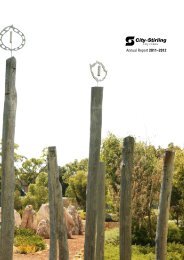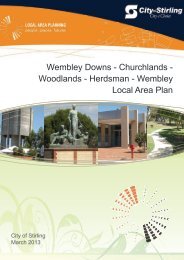MIRRABOOKA Local Area Plan - City of Stirling
MIRRABOOKA Local Area Plan - City of Stirling
MIRRABOOKA Local Area Plan - City of Stirling
Create successful ePaper yourself
Turn your PDF publications into a flip-book with our unique Google optimized e-Paper software.
Transport and Movement Network Pr<strong>of</strong>ile<br />
The transport and movement network influences how people carry<br />
out a variety <strong>of</strong> activities and can have significant impact on local<br />
communities and development. The ways that transport needs are<br />
planned are particularly significant given the impact <strong>of</strong> increasing<br />
financial costs <strong>of</strong> transportation on communities, the effects <strong>of</strong> car<br />
use and traffic congestion on quality <strong>of</strong> life and the urban form, as<br />
well as global environmental and socio-economic issues such as<br />
climate change and peak-oil.<br />
Current reliance on motor vehicles for transport is generally<br />
considered unsustainable in contrast to public transport, cycling and<br />
walking. These are more affordable, present fewer environmental<br />
costs, and provide opportunities for the development <strong>of</strong> healthy and<br />
safe communities. It is this context that underpins the following<br />
pr<strong>of</strong>ile <strong>of</strong> local transport and movement networks for the Mirrabooka<br />
<strong>Local</strong> <strong>Area</strong>.<br />
The <strong>City</strong> is developing an Integrated Transport Strategy which aims<br />
to encourage more sustainable and efficient transportation, a more<br />
accessible and equitable transport system and promotes public<br />
transport over private transport. It encourages (among other things)<br />
the development <strong>of</strong> local centres and linking these with public<br />
transport as well as strategic improvements to pedestrian and<br />
cyclist networks.<br />
Transportation Infrastructure<br />
The Mirrabooka <strong>Local</strong> <strong>Area</strong>, like much <strong>of</strong> the Perth Metropolitan<br />
Region, has been largely developed with motorist accessibility in<br />
mind and with less provision for walking, cycling and public<br />
transport.<br />
Roads Network, Traffic and Road Management<br />
The Mirrabooka <strong>Local</strong> <strong>Area</strong> is bound by four regional roads – Reid<br />
Highway (a primary regional road), Alexander Drive, Beach Road<br />
and Mirrabooka Avenue. Reid Highway connects the area with key<br />
employment destinations such as Balcatta and connects with<br />
Mitchell Freeway. The <strong>City</strong> controls all local roads and some<br />
regional roads such as Alexander Drive, Beach Road and<br />
Mirrabooka Avenue, whereas Main Roads Western Australia<br />
controls Reid Highway.<br />
In addition, the <strong>City</strong> has also lobbied for construction <strong>of</strong> overpasses<br />
at the intersections <strong>of</strong> Reid Highway and Alexander Drive and<br />
Mirrabooka Avenue. Numerous accidents have occurred at these<br />
intersections in recent times. The former State Government<br />
committed to the construction <strong>of</strong> the Alexander Drive overpass. As<br />
yet there has been no funding commitment towards construction <strong>of</strong><br />
an overpass at Mirrabooka Avenue.<br />
Pedestrian Amenity<br />
The Mirrabooka <strong>Local</strong> <strong>Area</strong> has been designed around a curvilinear<br />
and cul-de-sac layout, a result <strong>of</strong> 1970s and 1980s planning. In<br />
more recent times, difficulties associated with such street patterns<br />
have become evident. These include poor pedestrian legibility<br />
(ability to clearly see where you are in the area) and permeability<br />
(ability to easily get through the area). This is clearly evident in the<br />
Pedestrian Footpath Network diagram below. There is currently a<br />
lack <strong>of</strong> direct paved routes for pedestrians to take. These issues<br />
can discourage walking and cycling and given the lack <strong>of</strong> other<br />
pedestrians about, people may also feel less safe walking.<br />
Pedestrian Access Ways can however provide some links between<br />
40<br />
CITY OF STIRLING <strong>MIRRABOOKA</strong> LOCAL AREA PLAN<br />
January 2010


